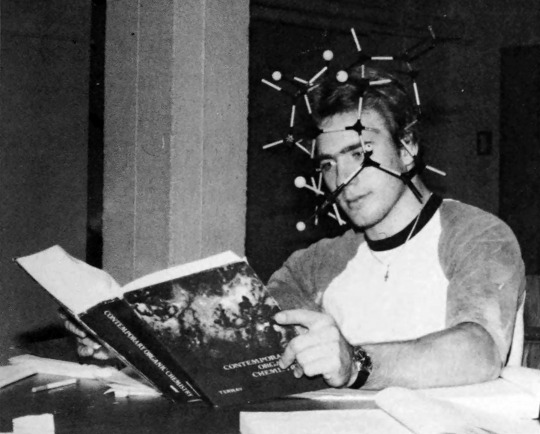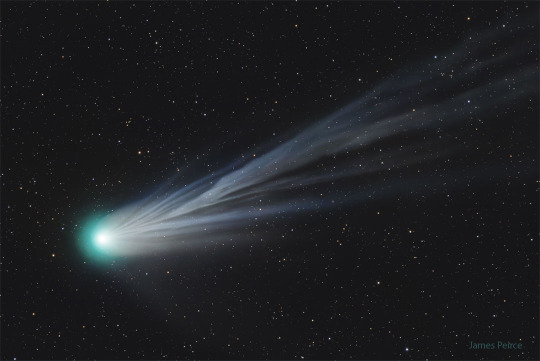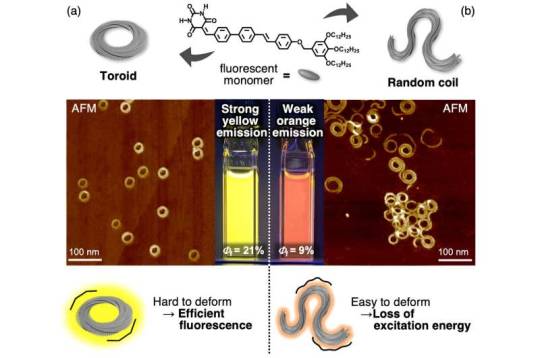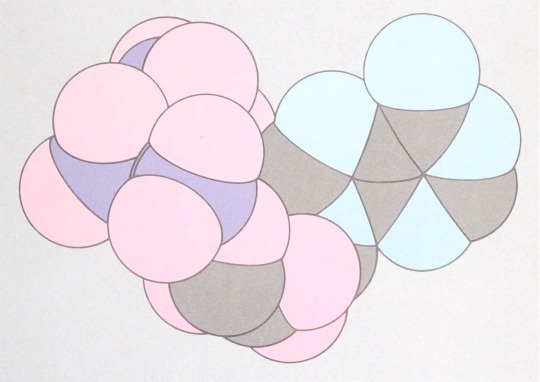#molecules
Text
Scientists have discovered a new way to destroy cancer cells. Stimulating aminocyanine molecules with near-infrared light caused them to vibrate in sync, enough to break apart the membranes of cancer cells.
Aminocyanine molecules are already used in bioimaging as synthetic dyes. Commonly used in low doses to detect cancer, they stay stable in water and are very good at attaching themselves to the outside of cells.
Continue Reading.
480 notes
·
View notes
Text
🌷
𝔾ü𝕟a𝕪𝕕ı𝕟
┏┓ 🌷Güzel Bir Hafta Geçirmeniz Dileğiyle
┃┃┏━┳┳┳ Her Şey Gönlünüzce Olsun
┃┗┫┃┃┃┃┻ 🌷Sonsuz Umutlarla
┗━┻━┻━┻━┛Mutluluğunuz Daim olsun .


247 notes
·
View notes
Text

Chemists create organic molecules in a rainbow of colors that could be useful as organic light-emitting diodes
Chains of fused carbon-containing rings have unique optoelectronic properties that make them useful as semiconductors. These chains, known as acenes, can also be tuned to emit different colors of light, which makes them good candidates for use in organic light-emitting diodes.
The color of light emitted by an acene is determined by its length, but as the molecules become longer, they also become less stable, which has hindered their widespread use in light-emitting applications.
MIT chemists have now come up with a way to make these molecules more stable, allowing them to synthesize acenes of varying lengths. Using their new approach, they were able to build molecules that emit red, orange, yellow, green, or blue light, which could make acenes easier to deploy in a variety of applications.
Read more.
67 notes
·
View notes
Text

Oxytocin
Watercolor
9”x12”
SOKD (commission)
Reprints available 🤗 message for the details
#art#artwork#women artists#artists on tumblr#watercolor#watercolorpainting#watercolor art#shibari#shibariart#oxytocin#molecules
54 notes
·
View notes
Text
If you could be nothing, you could also be everything. Once my molecules had dispersed, I would be here forever. Free. Part of the timeless. The sky and the ocean would also be me. Molecules never die, I thought.
— Lydia Millet, A Children's Bible: A Novel (W. W. Norton & Company; May 12, 2020)
126 notes
·
View notes
Text
Unraveling the Tapestry of Cellular Energy: A Comprehensive Voyage through the Electron Transport Chain 🧬⚙️
Prepare for a deep dive into the labyrinthine pathways of the Electron Transport Chain (ETC), where molecular machinations weave the intricate tapestry of cellular respiration. In this odyssey, we'll navigate the complexities with surgical precision, leaving no nuance unexplored.
1. Prelude at Complex I (NADH Dehydrogenase):
The ETC's overture commences at Complex I, where NADH, a product of glycolysis and the Krebs cycle, surrenders its high-energy electrons. Traverse the serpentine route of flavin mononucleotide (FMN) and a succession of iron-sulfur clusters, witnessing the orchestrated dance that propels electrons toward the enigmatic ubiquinone (Q).
2. Interlude with Succinate (Complex II - Succinate Dehydrogenase):
As the symphony progresses, Complex II takes the stage with succinate as its protagonist. Succinate dehydrogenase, fueled by succinate from the Krebs cycle, orchestrates a parallel electron flow. Behold the ballet of electrons navigating iron-sulfur clusters and flavin adenine dinucleotide (FAD), converging upon ubiquinone (Q) in a seamless choreography.
3. Cytochrome Waltz (Complex III - Cytochrome bc1 Complex):
The narrative crescendos at Complex III, the cytochrome bc1 complex, where Q takes center stage. Through a series of mesmerizing redox reactions, Q gracefully shuttles electrons to cytochrome c. This transient dancer becomes the ethereal messenger, ferrying electrons with finesse towards the climactic rendezvous at Complex IV.
4. Grand Finale with Complex IV (Cytochrome c Oxidase):
In the climactic finale, Complex IV, personified by cytochrome c oxidase, awaits the electron ensemble. Watch as electrons, guided by a cascade of copper and iron centers, engage in a captivating pas de deux with molecular oxygen. Witness the alchemical metamorphosis as oxygen is humbly transmuted into water, marking the zenith of our electron saga.
5. Proton Symphony and ATP Synthesis:
Simultaneously, the proton symphony unfolds as protons, displaced during electron transit, accumulate in the intermembrane space. This sets the stage for a grand energy transfer. The finale crescendos with protons flowing back through ATP synthase, a molecular turbine, culminating in the synthesis of ATP—the lifeblood of cellular energy currency.

References:
1. Alberts, B., Johnson, A., Lewis, J., Raff, M., Roberts, K., & Walter, P. (2014). Molecular Biology of the Cell (6th ed.). Garland Science.
2. Nelson, D. L., Cox, M. M. (2017). Lehninger Principles of Biochemistry (7th ed.). W.H. Freeman and Company.
3. Berg, J. M., Tymoczko, J. L., Gatto, G. J. S., & Stryer, L. (2019). Biochemistry (8th ed.). W.H. Freeman and Company.
#science#biology#college#education#school#student#medicine#doctors#health#healthcare#molecules#chemistry#molecular biology
53 notes
·
View notes
Text
A group of atoms bonded together is called a molecule.
What do you call a group of molecules bonded together?
a polycule.
102 notes
·
View notes
Text
There’s so much to tell you and I’m frankly running out of time
Quantum entanglement tells us that quantumly connected particles can never be described by themselves, even when they’re miles apart from each other. Simply put, this means that an action on one of the particles will invariably affect the other, no matter the distance between them. Albert Einstein called this “spooky action at a distance”.
“Hyper independence is a response to trauma”, you read out from WebMD while squeezing my hand, shocked at the fact that hurt from others can lead you to rely on self and no one else. the squeeze on my hand finally makes Schrödinger’s cat experiment makes sense. I feel alive and dead at the same time.
We lean on each other and I’ve been thinking about it. The science behind it. Turns out that we once were very lonely people and the heaviness of it all tends to lead us to settle on other seemingly lean, warm things.
You tell me that being known is the most horrible thing you can think of because it’s self confrontation of things that you already know about yourself from someone else’s mouth. Mortifying. You tell me this while I dim out the lights after sunset because your mom always did so when you were small and you felt happy because you knew your dad would come home in an hour and you say this while I touch your back and you straighten it on reflex because you’ve been trying to fix your posture. My point is that I know you and my point is that I still love you.
I want to write like I did when I was 15. Like no one was watching. I want to live like I did when I was 8. Why is being loved associated with being seen? I want to be loved when I’m not seen. I remember way too much and I know way too little and I write something and everything is somehow always the same thing. I wanted to know everything but now knowing is doing me absolutely no good. I want to say less self depreciating jokes but then I say “ravioli ravioli give me the death I deservioli” like it’s not an overused twitter reaction photo and you laugh so hard and for a split second all I feel is alive.
There’s so much to tell you and I’m running out of time so please just ask me to stay.
Meanwhile, Einstein shakes his head and calls it spooky action at a distance when you smile at me telling you over video call that I gave up and called an electrician to fix the exhaust fan.

quantum entanglement
Artwork by Holly Warbuton
#original writing#original post#original fiction#writing#quantum entanglement#quantum physics#molecules#albert einstein#hyper independence#nerd#nerd alert#schrodinger#the mortifying ordeal etc etc#the mortifying ordeal of being perceived#mortifying ordeal of being known#lovecore#love poetry#me and who#holly warburton#web weaving
112 notes
·
View notes
Photo

Source details and larger version.
Here's my gallery of unusual imagery from vintage college yearbooks.
16 notes
·
View notes
Text
Whereas humans have one receptor on their tongues that can detect all sorts of sweet things, from real sugar to artificial sweeteners like aspartame, insects have many receptors that each detect specific types of sugars.
The new research reveals one way insect receptors are able to be so selective. The new discovery will help us understand how animals decipher the chemical world and how we might mimic that ability in the future, the researchers say.
Continue Reading.
83 notes
·
View notes
Text
2024 March 26
A large comet is shown with its head near the right and a light blue flowing ion tail flowing across into the rest of the image.

Comet Pons-Brooks' Ion Tail
Image Credit & License: James Peirce
Explanation: Comet Pons-Brooks has quite a tail to tell. First discovered in 1385, this erupting dirty snowball loops back into our inner Solar System every 71 years and, this time, is starting to put on a show for deep camera exposures. In the featured picture, the light blue stream is the ion tail which consists of charged molecules pushed away from the comet's nucleus by the solar wind. The ion tail, shaped by the Sun's wind and the comet's core's rotation, always points away from the Sun. Comet 12P/Pons–Brooks is now visible with binoculars in the early evening sky toward the northwest, moving perceptibly from night to night. The frequently flaring comet is expected to continue to brighten, on the average, and may even become visible with the unaided eye -- during the day -- to those in the path of totality of the coming solar eclipse on April 8.
#astronaut#astronomers#not astrology#star#stars#art#astronomy#outer space#space#artist#comet#1385#solar system#blue#ion#molecules#sun#comet 12p/pons brooks#solar eclipse#eclipse#april 8#april 8 eclipse
17 notes
·
View notes
Text
Researchers detect a new molecule in space
New Post has been published on https://thedigitalinsider.com/researchers-detect-a-new-molecule-in-space/
Researchers detect a new molecule in space


New research from the group of MIT Professor Brett McGuire has revealed the presence of a previously unknown molecule in space. The team’s open-access paper, “Rotational Spectrum and First Interstellar Detection of 2-Methoxyethanol Using ALMA Observations of NGC 6334I,” appears in April 12 issue of The Astrophysical Journal Letters.
Zachary T.P. Fried, a graduate student in the McGuire group and the lead author of the publication, worked to assemble a puzzle comprised of pieces collected from across the globe, extending beyond MIT to France, Florida, Virginia, and Copenhagen, to achieve this exciting discovery.
“Our group tries to understand what molecules are present in regions of space where stars and solar systems will eventually take shape,” explains Fried. “This allows us to piece together how chemistry evolves alongside the process of star and planet formation. We do this by looking at the rotational spectra of molecules, the unique patterns of light they give off as they tumble end-over-end in space. These patterns are fingerprints (barcodes) for molecules. To detect new molecules in space, we first must have an idea of what molecule we want to look for, then we can record its spectrum in the lab here on Earth, and then finally we look for that spectrum in space using telescopes.”
Searching for molecules in space
The McGuire Group has recently begun to utilize machine learning to suggest good target molecules to search for. In 2023, one of these machine learning models suggested the researchers target a molecule known as 2-methoxyethanol.
“There are a number of ‘methoxy’ molecules in space, like dimethyl ether, methoxymethanol, ethyl methyl ether, and methyl formate, but 2-methoxyethanol would be the largest and most complex ever seen,” says Fried. To detect this molecule using radiotelescope observations, the group first needed to measure and analyze its rotational spectrum on Earth. The researchers combined experiments from the University of Lille (Lille, France), the New College of Florida (Sarasota, Florida), and the McGuire lab at MIT to measure this spectrum over a broadband region of frequencies ranging from the microwave to sub-millimeter wave regimes (approximately 8 to 500 gigahertz).
The data gleaned from these measurements permitted a search for the molecule using Atacama Large Millimeter/submillimeter Array (ALMA) observations toward two separate star-forming regions: NGC 6334I and IRAS 16293-2422B. Members of the McGuire group analyzed these telescope observations alongside researchers at the National Radio Astronomy Observatory (Charlottesville, Virginia) and the University of Copenhagen, Denmark.
“Ultimately, we observed 25 rotational lines of 2-methoxyethanol that lined up with the molecular signal observed toward NGC 6334I (the barcode matched!), thus resulting in a secure detection of 2-methoxyethanol in this source,” says Fried. “This allowed us to then derive physical parameters of the molecule toward NGC 6334I, such as its abundance and excitation temperature. It also enabled an investigation of the possible chemical formation pathways from known interstellar precursors.”
Looking forward
Molecular discoveries like this one help the researchers to better understand the development of molecular complexity in space during the star formation process. 2-methoxyethanol, which contains 13 atoms, is quite large for interstellar standards — as of 2021, only six species larger than 13 atoms were detected outside the solar system, many by McGuire’s group, and all of them existing as ringed structures.
“Continued observations of large molecules and subsequent derivations of their abundances allows us to advance our knowledge of how efficiently large molecules can form and by which specific reactions they may be produced,” says Fried. “Additionally, since we detected this molecule in NGC 6334I but not in IRAS 16293-2422B, we were presented with a unique opportunity to look into how the differing physical conditions of these two sources may be affecting the chemistry that can occur.”
#2023#ALMA#Astronomy#Astrophysics#atoms#chemical#chemistry#college#complexity#data#Denmark#detection#development#Discoveries#earth#ether#fingerprints#form#France#how#interstellar#it#learning#Light#Machine Learning#measure#measurements#members#mit#molecules
15 notes
·
View notes
Photo

High-resolution images of terminals in water chains.
Shiotari, A., Sugimoto, Y. Ultrahigh-resolution imaging of water networks by atomic force microscopy. Nat Commun 8, 14313 (2017). https://doi.org/10.1038/ncomms14313
153 notes
·
View notes
Photo

Source details and larger version.
Attributing human characteristics to animals and things: my bizarre collection of a thousand anthropomorphism images.
25 notes
·
View notes
Text

Exploring the effect of ring closing on fluorescence of supramolecular polymers
In supramolecular chemistry, the self-assembly state of molecules plays a significant role in determining their tangible properties. Controlling the self-assembled state has garnered significant attention as it can be exploited to design materials with desired properties like charge transport capability and fluorescence wavelength.
For years, scientists have been trying to decipher how molecular organization impacts the properties of supramolecular assemblies that are in the nano (<10 nm) and mesoscopic (10–1,000 nm) scales. However, the study of structures with supramolecular polymer assemblies derived from the same monomer is often hindered by dynamic structural changes and immature control over self-assemblies.
A recent study published in the Journal of the American Chemical Society, investigated the properties of one-dimensional mesoscale supramolecular assemblies of two different structures composed of the same luminescent molecule. It showed how two structures showed very different properties depending on whether they had their molecules arranged in a closed circular pattern or not.
Read more.
#Materials Science#Science#Fluorescence#Polymers#Supramolecular#Self assembly#Molecules#Chiba University
13 notes
·
View notes
